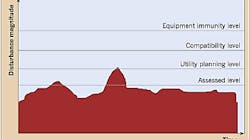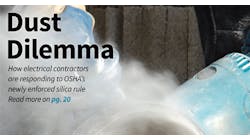What power quality can you expect from your utility?
Accurately predicting your supply system's power quality will help you find the best design for your equipment specifications
Most utilities are required to submit reliability performance statistics to their regulators. However, they typically don't provide detailed information on the full range of power quality characteristics that are important to their commercial and industrial customers, including the expected number of voltage sags and interruptions, harmonic distortion levels, voltage unbalance, and voltage variations. The IEEE and the International Electrotechnical Commission (IEC) have developed standards to provide guidance in some of these areas. Other events such as voltage sags, are just starting to receive attention.
What do you need to know to make sure your equipment works properly? What levels of power quality can you expect? It's useful to divide power quality considerations into two categories: Steady-state, also called continuous, characteristics and disturbances.
Steady-state power quality. The first category of characteristics refers to the quality of the normal voltage supplied to your facility. In other words, how much can the voltage magnitude vary from the nominal value? How distorted is the voltage? What is the unbalance between the 3-phase voltages? It's possible to quantify all of these characteristics and develop limits for the variations.These are the power quality characteristics that have received the most attention from the standards developing committees. For instance, the European standard EN50160 provides minimum performance requirements for the electric supply in all of the steady-state power quality categories, which are evaluated using statistical procedures. Using statistics to characterize the supply's performance makes it possible to compare the results with the statistical characteristics of equipment immunity to power quality variations.
The objective is to define a performance level that can be achieved with a reasonable investment in the power system and will also be unlikely to cause equipment problems. This level is called the compatibility level and is defined with statistics. For example, it's common to define the compatibility level for performance evaluations as the level that may not be exceeded more than 5% of the time. In other words, there's a 95% probability that the level won't be exceeded. Fig. 1 above illustrates the compatibility level concept compared to a time trend of a steady-state power quality characteristic. Fig. 1 also shows several other important power quality levels, including the following:
- Equipment immunity level
Equipment performance may be negatively affected if this level is exceeded. It's also defined statistically. There should be some margin between the compatibility level for the supply and the equipment immunity level.
- Utility planning level
The electric utility will establish this level as its design objective. Usually, the utility sets the planning level somewhere below the compatibility level to help ensure it won't exceed the actual compatibility level. For example, the compatibility level for harmonic voltage distortion might be 5% but the planning level might be 4%, ensuring the 5% level isn't exceeded.
- Assessed level
This is the actual level that exists on the system. It's usually based on measurements. For example, the evaluation of performance for the European standards requires measurements over a one-week period. So the assessed level, used for comparison with the minimum performance requirements and based on the compatibility level, is the level exceeded for 5% of the measurements (one measured value every 10 min).
So what are the compatibility levels for the steady-state power quality characteristics? The Table above summarizes typical supply system requirements in the important steady-state power quality categories. Minimum power quality requirements don't exist in most states, as they do in Europe and in many other countries, but you can reasonably expect from your supply system the levels indicated in the Table. If any of these levels are being exceeded, it's likely that your electric supplier will work to find the problem and improve the quality of its supply.
It's also important to remember that the power quality levels indicated in the Table are considered normal, so don't assume that your power quality levels will be significantly better than those indicated here. For example, if you're applying power factor correction, it's reasonable to assume that the background harmonic distortion levels on the supply system could be as high as 3% for individual harmonics and 5% for the total distortion. This could influence your design requirements for power factor correction equipment within your facility.
Disturbances. Disturbances are power quality variations that can't be characterized with the same time trends and statistical distributions used for steady-state power quality characteristics. Disturbances refer to power quality variations that occur at random intervals yet aren't associated with the steady-state characteristics of the voltage. The variations include outages (reliability), momentary interruptions, voltage sags, and transients. They can all affect your facility, depending on the sensitivity of your equipment and the investments you've made in power conditioning equipment.The most commonly discussed type of disturbance is the outage. Most utilities around the world report on the reliability performance of their power system. The System Average Interruption Frequency Index (SAIFI) is a common index used to track reliability for power systems. Based on the reported number of power outages customers experience each year, the index can give you a good indication of what to expect in your area. The index defines an outage as an interruption that lasts more than 5 min. For power systems in most developed countries the average SAIFI levels range from .5 to 5.0 interruptions per year, depending on factors like weather, the system's exposure to elements, and whether it's in a networked or radial configuration. The average SAIFI across the United States is about 1.3 outages per year. The index is typically used to evaluate the performance of the system for events that system investments or maintenance could prevent, so it's adjusted to exclude major events that affect a significant portion of the system, such as ice storms, tropical storms, or hurricanes.
Information about the average number of outages that you could experience is interesting, but it's much more useful to get information about the expected number of outages where you're actually connected to the system. Your utility may be able to provide location-specific historical data about reliability that would be more useful for evaluating the need for a UPS or backup generation to protect your critical operations.
Unfortunately, facility operations can be affected by more than just long-duration outages. Momentary voltage sags lasting less than 100 ms are often sufficient to cause disruptions to sensitive equipment and operations. Even though the effects of these disturbances can be the same as long-duration outages, voltage sags can be more important because they occur much more frequently. Faults on distribution and transmission circuits cause these disturbances. The interconnected nature of the system means that faults remote from a facility can still cause a momentary voltage sag that could be sufficient to affect operations.
Many utilities can't even provide information to customers about the expected number of voltage sags they're likely to experience. From 1993 to 1995 EPRI conducted the Distribution Power Quality Project, in which it monitored almost 300 locations across the United States. The benchmarking study provided an estimate for the average number of voltage sags customers experience on distribution systems in the country, and the results were presented at the IEEE 1999 Summer Power Meeting. To present the results of this extensive benchmarking project, they developed System Average rms (Variation) Frequency Index (SARFI), an index used to describe voltage sag performance. The index represents the average number of voltage sags with a specified characteristic experienced by a customer each year. For SARFIX, the index would include all of the voltage dips where the minimum voltage was less than x. For example, SARFI70 represents the expected number of voltage sags in situations where the minimum voltage is less than 70%.
SARFI indices become a very important consideration for many process industry customers because the indices represent events that effect the reliability of the process. There are typically very few actual outages. Therefore, voltage sags represent the most important power quality variation affecting industrial and commercial customers. The IEEE Gold Book (IEEE Standard 493) describes how you should consider the impact of voltage sags as part of your economic evaluation of plant reliability:
“Economic evaluation of reliability begins with the establishment of an interruption definition. Such a definition specifies the magnitude of the voltage sag and the minimum duration of such a reduced-voltage period that results in a loss of production or other function of the plant process.”
The SARFI index appropriate for your facility will depend on the sensitivity of your facility's equipment to these voltage variations. This information may not be available without extensive monitoring and evaluation of equipment response to actual disturbances. Fig. 2 from the prior mentioned EPRI benchmarking project, shows how the voltage sag performance is dependent on the minimum voltage level being considered. For instance, the average for the number of voltage sags per year with a minimum voltage less than 70% is about 18 events per year in the United States. However, if equipment could be affected by a voltage sag with a minimum voltage of 90% — a very minor voltage sag — then the number of events per year is about 50. The sensitivity of your equipment is a critical factor in the importance of these disturbances.
Again, average statistics, especially nationwide statistics, aren't very useful for determining whether a facility needs to invest in power conditioning equipment or even if such an investment is economically justified. Figures on expected voltage sag performance at the individual plant location would be useful. Some utilities, like United Illuminating (UI), a regional electric distribution company in Connecticut, calculate the expected voltage sag performance throughout their systems.
UI monitors all of its substations and maintains performance statistics that are updated quarterly. Fig. 3 is an example of the voltage sag performance (SARFI70) across all of the facility's substations, which shows the three-year average voltage sag performance compared with the voltage sag performance in the last year. UI can provide this information to any of its customers to help them understand the power quality they can expect at the point where they're connected to the system.
Transient overvoltages can also be an important consideration for the quality of supply. Lightning or almost any switching event on the power system can cause transients, so it's a good practice to include surge protection for your facility or at least your critical equipment.
But even with protection against high-magnitude transients, transient voltages may still be able to affect your equipment. For example, capacitor switching transients can sometimes affect adjustable speed drives (ASDs), as shown in Fig. 4 (print version only), because they can have enough energy to charge up the DC capacitor in the drives to levels that would cause tripping on the DC overvoltage setting. Capacitor switching transients can also cause problems for low-voltage power factor correction equipment, electronic ballasts for fluorescent lighting, and other electronic equipment. Understanding that transients like the one in Fig. 4 are a normal part of your supply system operation can help in developing appropriate specifications for ASDs and other critical equipment.
There is a wide range of power quality variations that a facilities engineer must recognize. Understanding the power quality you can expect from the supply system is a critical part of developing the best design for your equipment specifications and for facility protection. In general, equipment should be designed to withstand the normal steady-state power quality variations you can expect as part of the normal operation of the power system. However, it's unrealistic to expect your equipment to handle all disturbances that may occur. Understanding the expected disturbances and how often they can occur is necessary to optimize investments in equipment protection.
McGranaghan is vice president of consulting services for EPRI-PEAC, Knoxville, Tenn.



